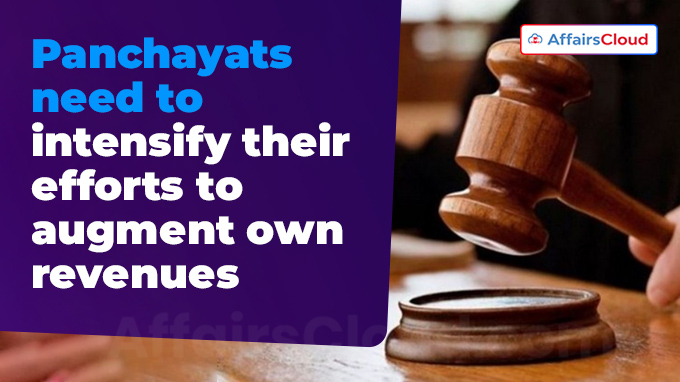 Reserve Bank of India (RBI)’s report titled ‘Finances of Panchayati Raj Institutions’ states that Panchayats has to boost their efforts to increase their own revenues (which includes tax and non tax revenue) and improve their governance towards sustainable growth.
Reserve Bank of India (RBI)’s report titled ‘Finances of Panchayati Raj Institutions’ states that Panchayats has to boost their efforts to increase their own revenues (which includes tax and non tax revenue) and improve their governance towards sustainable growth.
- According to the report, the own revenues of the panchayats accounts for only 1.1% of their total revenue.
About the report:
i.The report presents an analysis of Panchayats finances and their role in India’s socio-economic development.
ii.The report has been prepared in the Division of Local Finances (DLF) of the Department of Economic and Policy Research (DEPR).
iii.The assessment covered around 75% of the total number of Rural Local Bodies (RLBs) in India.
Highlights:
i.Panchayat generates their own revenues by imposing local taxes, fees, and charges on various activities, including land revenue, professional and trade taxes, and miscellaneous fees.
ii.The non-tax revenue of Panchayats (from Panchayati Raj programmes and interest earning) accounted for 3.3% of its total earning.
iii.About 95% of their revenue comes from grants, limiting their spending.
- Panchayats receive grants from both Central and State governments.
- These grants may be distributed under specific schemes or based on the Central Finance Commission’s (CFC) and State Finance Commissions’ (SFC) recommendations.
iv.Delays in the constitution of SFCs further hinder their financial capabilities.
v.States with higher devolution levels to Panchayats exhibit better outcomes in health, education, infrastructure, water supply and sanitation.
Receipts:
i.Panchayats in Tamil Nadu (TN), Himachal Pradesh (HP), Maharashtra, and Telangana reported higher non-tax revenue than others
ii.The average revenue per Panchayat, encompassing taxes, non-taxes, and grants, was at Rs 21.2 lakh in 2020-21, Rs 23.2 lakh in 2021-22, and Rs 21.23 lakh in 2022-23.
iii.The average revenue per Panchayat varied from Rs 2.7 lakh in Andhra Pradesh (AP) to Rs 64 lakh in West Bengal (WB).
Expenditure:
i.The average expenditure per Panchayat witnessed a decline from Rs 17.3 lakh in 2020-21 to Rs 12.5 lakh in 2022-23.
ii.States of Goa, Karnataka, Odisha, Sikkim, Kerala, and Tamil Nadu recorded the highest average expenditure at the Panchayat level.
iii.The ratio of revenue expenditure of Panchayats to nominal Gross State Domestic Product (GSDP) remained below 0.6% for all states.
iv.The composition of expenditure indicated a consistent rise in spending on water and sanitation, reflecting emphasis on cleanliness and access to clean water supply.
v.Investment in capital projects constituted 29.6% of the total expenditure of Panchayats in 2022-23, on average, across States.
Key Points:
i.The revenue to capital expenditure ratio averaged 3.2 in 2022-23
ii.68.8% of India’s population in rural areas, making panchayats crucial for implementing government policies.
iii.Panchayats bridge community-government gap, fostering grassroots development and sustainability.
iv.Panchayati Raj Institutions (PRIs) promote climate-resilient farming, renewable energy, reducing reliance on fossil fuels.
v.There is also a need to raise citizens’ awareness about the functions and significance of PRIs by encouraging their increased participation in local governance processes.
vi.Article 243-I mandates SFC every five years to assess Panchayats’ financial status and propose tax-sharing frameworks between the State and Panchayats. However, SFC formation is inconsistent across states.
Types of Grants that PRIs get:
i.Untied Grants: General-purpose grants without specific conditions, allowing utilization based on local priorities.
ii.Tied Grants: Allocated for specific sectors like sanitation or education, ensuring directed funding according to government priorities.
iii.Performance-based Grants: Linked to performance criteria, rewarding PRIs with effective governance and successful project implementation.
iv.Special Category Grants: Designed to address unique challenges or needs in specific regions, providing additional support based on socioeconomic or geographical constraints.
Recent Related News:
i.According to the State Bank of India (SBI) research paper titled “PM SVANidhi: Strengthening the Country’s Social Fabric by Empowering Grassroot Market Mavericks” 75% of the beneficiaries of the PM SVANidhi scheme are from the non-general category.
ii.The United Nations Food and Agriculture Organization (FAO) released a report titled ‘The Impact of Disasters on Agriculture and Food Security 2023-Avoiding and reducing losses through investment in resilience‘ which is the first–ever global estimation of the impact of disasters on agricultural production focused on crops and livestock.
Panchayats:
i.In 1992, the 73rd Amendment to the Indian Constitution institutionalised the PRIs at three levels in rural India: Gram Panchayats at the village level, Mandal Panchayats at the intermediate/block level, and Zila Parishad at the district level.
ii.There are total of 2.62 lakh PRIs in India, with 2.55 lakh Gram Panchayats, 6,707 Mandal Panchayats, and 665 Zila Parishads as of October 2023.
iii.Article 243-H of the Constitution empowers Panchayats to impose, collect, and allocate taxes, duties, tolls, and fees.




